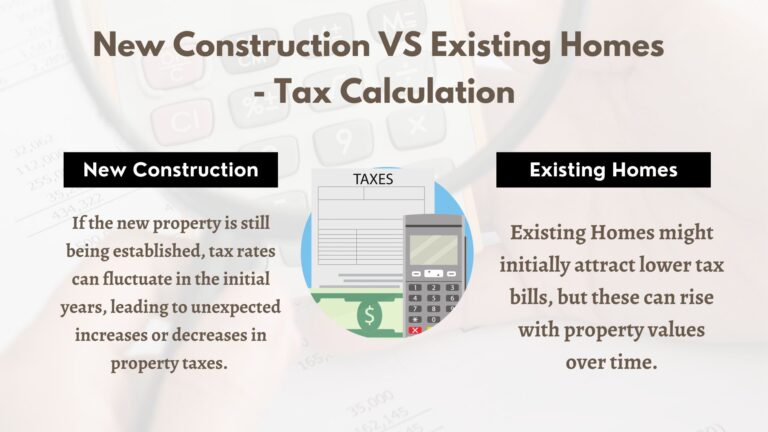
When buying a home, understanding the costs of property taxes is critical for budgeting and financial planning. But for first-time buyers, navigating the complexities of property taxes can feel like deciphering a foreign language. This is especially true when comparing the property tax obligations for new construction and existing homes.
In this blog, let’s dive into the differences in property tax assessments for these two types of properties, helping you make informed decisions.
How are New Construction and Existing Homes Assessed for Tax Calculation?
Both new and existing homes undergo property tax assessments, determining their “taxable value”- estimated market worth of the property used to calculate your annual tax bill. The process involves comparing your property to similar ones in your area, considering factors like size, location, and amenities.
New Construction
New construction homes undergo an initial assessment once construction is complete. For freshly built homes, the assessor typically relies on land value, construction costs, permits, comparable properties, and even fancy upgrades like swimming pools. This typically leads to a higher assessed value initially, and consequently, potentially higher property taxes in the first few years. If the new property is still being established, tax rates can fluctuate in the initial years, leading to unexpected increases or decreases in property taxes.
Existing Homes
Existing homes usually have an established market value based on past sales and assessments, often lower than brand new ones. However, property tax rates for existing homes change gradually, typically based on inflation or cost-of-living adjustments. Moreover, renovations or additions can trigger reassessments, potentially increasing the value and, in turn, the tax burden. To sum it up, existing homes might initially attract lower tax bills, but these can rise with property values over time.

Tax Rates and Bills
Once your home’s value is set, the tax rate applied to it determines your annual bill. These rates vary by location, with municipalities setting them to fund local services like schools and roads. For example, as of 2023, the average effective property tax rate in Texas is 1.60%. Generally, the tax rate stays constant, but the assessed value can fluctuate, impacting your bill over time.
Tax Advantages of New Construction
While new construction homes might carry a higher initial tax burden, they often come with benefits. Many states offer tax incentives for energy-efficient features or first-time homebuyers, reducing your tax bill. Additionally, newer homes tend to depreciate at a slower rate, potentially mitigating future tax increases.
Tax Advantages with Existing Properties
Older homes may have lower assessed values and, consequently, lower property taxes. Additionally, their established tax history creates predictability in future bills. You may also find tax breaks for historic preservation or other programs specific to older homes in your area.
How to Choose Between New Construction and Existing Homes?
Choosing between new construction and existing homes involves many factors, and property taxes are just one piece of the puzzle. While new homes might initially cost more in taxes, they offer potential savings through incentives and slower depreciation. Existing homes have established tax profiles and may benefit from specific programs, but renovations can trigger reassessments. Ultimately, the best choice depends on your budget, preferences, and local policies.
Be Watchful of Incorrect or Inaccurate Evaluations
No doubt, property taxes play a significant role in your overall homeownership costs, and understanding the nuances can contribute to effective budgeting and financial planning. However, instances of incorrect property assessments are not uncommon. And in such cases, Alamo Ad Valorem can be your ally. With our expertise in property tax appeals, they ensure you pay your fair share and not a cent more. Don’t hesitate to seek our support if you suspect an incorrect evaluation.

